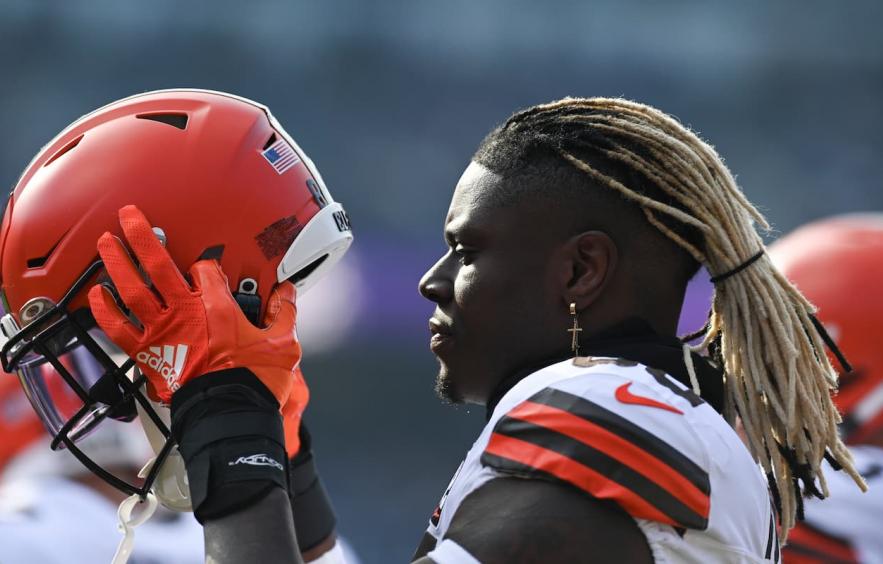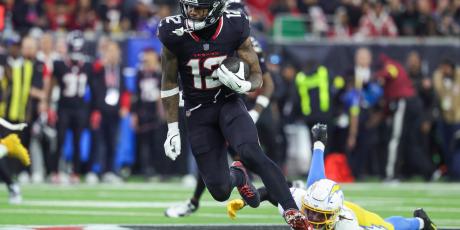The Most Predictable Tight End Stats

The importance of athleticism is the biggest difference between WR and TE predictive metrics. That won’t be a surprise if you’re a fan of the NFL Combine. The relative athletic scores (RAS) of TE prospects are impossible to avoid leading up to draft season. While athleticism isn’t especially predictive for college WR prospects joining the pros, it is at TE. Tight ends do not have to be a featured part of an offense’s passing attack. There are plenty of block-first TEs in the NFL. A TE needs to be talented to convince an offensive coordinator that he should be a focal point of the offense.
More Predictable Stats: QB | RB | WR
Proxies for athleticism like yards after catch (YAC) and tackle avoidance are among the top five most important variables in my TE prospect model. And that connection holds for players already in the league. Broken and missed tackles per reception are stickier year-over-year and about twice as predictive for TEs compared to WRs. With that in mind, we’ll add in athleticism when looking at a TE’s talent before turning to efficiency and volume metrics.
Methodology
This analysis considered 23 statistics for tight ends who earned at least 30 targets in consecutive seasons. Every statistic analyzed is a rate statistic rather than a volume statistic. For example, we’re using yards per route run rather than total yards in a season. This allows us to more easily compare tight ends with differing opportunities.
As for the time period, we’re using 2017-2023 for two reasons. The first is that some advanced statistics from ESPN Analytics like open score are only available starting in 2017. The second reason is the correlations for the available statistics don’t change drastically if you extend the time period.
Consistent Variables
With that methodology in mind, let’s find out how consistent tight end statistics are year-over-year. The table below shows the correlation of a variable between consecutive seasons. What you’ll notice is volume statistics dominate the top of the table. Per-game marks for yards, targets, and receptions are the stickiest variables year-over-year, and yards in particular are strongly correlated with next season’s fantasy points per game. We ultimately want the talent and efficiency metrics we’ll focus on below to turn into actual production.
And just like for WRs, things like contested catch rate, drop rate, and TD rate are inconsistent. There is essentially no correlation year-over-year for any of these metrics and very little predictive power for next season’s fantasy points. That’s the reason projections will regress to the mean extremely high or low TD rates from the prior season.
| Variable | Correlation |
|---|---|
| Yards Per Game | 0.71 |
| Targets Per Game | 0.68 |
| Receptions Per Game | 0.67 |
| Fantasy Points Per Game | 0.66 |
| Route Rate | 0.61 |
| Yards Per Route Run | 0.60 |
| Open Score | 0.60 |
| Average Depth of Target | 0.59 |
| Average Depth of Completion | 0.57 |
| YAC Score | 0.56 |
| Slot Rate | 0.56 |
| First Downs Per Route Run | 0.54 |
| Broken and Missed Tackles Per Reception | 0.53 |
| Yards Per Reception | 0.52 |
| Yards After Catch Per Reception | 0.51 |
| Targets Per Route Run | 0.50 |
| Points Earned Per Route | 0.40 |
| On-Target Catch Percentage | 0.23 |
| EPA Per Target | 0.20 |
| Catch Score | 0.14 |
| TD Rate | 0.11 |
| Drop Rate | 0.10 |
| Contested Catch Rate | 0.05 |
Predictive Variables
The table below extends our analysis further by comparing the correlation of each variable with a tight end’s fantasy points per game in the next season. Just like at WR, the most predictive variable strictly related to a player’s talent was ESPN Analytics’ open score. This variable uses player tracking data from NFL Next Gen Stats. For each route that a TE runs, an expected amount of separation is calculated by using historical data and the route, coverage, and depth of the particular play. A TE is then given an open score based on their separation relative to the benchmark. The score is standardized to range between zero and 99 where 50 is the league average.
With respect to efficiency, the two most predictive variables are yards per route run (YPRR) and first downs per route run (1DRR). And then as mentioned, yards per game is both the most predictive volume and overall metric for next season’s fantasy points.
| Variable | Correlation |
|---|---|
| Yards Per Game | 0.68 |
| Fantasy Points Per Game | 0.66 |
| Targets Per Game | 0.62 |
| Receptions Per Game | 0.62 |
| Yards Per Route Run | 0.54 |
| First Downs Per Route Run | 0.49 |
| Targets Per Route Run | 0.45 |
| Open Score | 0.44 |
| Points Earned Per Route | 0.43 |
| Yards Per Reception | 0.35 |
| EPA Per Target | 0.28 |
| YAC Score | 0.27 |
| Average Depth of Completion | 0.23 |
| Broken and Missed Tackles Per Reception | 0.21 |
| Average Depth of Target | 0.20 |
| Yards After Catch Per Reception | 0.19 |
| Catch Score | 0.16 |
| Contested Catch Rate | 0.13 |
| Slot Rate | 0.08 |
| TD Rate | 0.07 |
| Route Rate | 0.07 |
| Drop Rate | 0.04 |
| On-Target Catch Percentage | 0.04 |
Talent: Open Score and Broken/Missed Tackles
The starting point for a tight end’s future performance expectation is talent. And as mentioned, ESPN Analytics’ open score is both consistent and predictive. The graph below is a partial dependence plot (PDP) of TE open scores. PDPs are a great way to shine some light on the inner workings of machine learning models. They show how each variable affects the model’s predictions while averaging out the effects of the other variables. It’s easiest to focus on the orange line in the graph. As that orange line increases above zero on the y-axis, it means TEs in that range typically score more fantasy points next season. The main takeaway here is we want our TE to have an open score of at least 40. That’s the level where we start to see more positive outcomes in the following season.

Now athleticism is the primary difference between the talent evaluation of TEs versus WRs. If a TE isn’t a special player, they might be tasked with blocking an edge rusher rather than running a route. And that’s great for your points per block league but not ideal for most of us. The proxy for athleticism that provided the most model gain was broken and missed tackles per reception (BT+MT/Rec). The graph below is a PDP of just that. We start seeing positive fantasy point outcomes when a TE avoids being tackled on about 10% of his receptions. And then we see the best outcomes when that rate of tackle avoidance exceeds 15%.

Efficiency: YPRR and 1DRR
To improve our confidence that a TE is talented, we’d like to see that talent manifest in efficiency. As we saw, the efficiency metric that correlates the most with future fantasy points is YPRR. And the best outcomes next season tend to come from TEs that earned at least 1.75 yards per route run the prior year. But similar to rushing yards over expected (RYOE) for running backs, YPRR can be skewed by big plays. With running backs, though, we found that success rate did a poor job of providing additional context. Fortunately, TEs have a success rate metric that is nearly as predictive as YPRR.

Ryan Heath has a great article Statistically Significant: First Downs Per Route Run if you’d like to dive more deeply. But the logic is that good players tend to generate successful plays more frequently. But the binary nature of a first down caps the benefit that any individual play can have on the statistic. One first down counts the same as any other first down, while a 99-yard reception can heavily skew YPRR. What I’ve found is the good outcomes for future-season fantasy points come from TEs that earn first downs on at least 9.5% of their routes, with elite outcomes stemming from 10%+ 1DRR marks.

Very few TEs were able to reach the 9.5% 1DRR mark in 2023. And all of the TEs that managed this feat also had a YPRR that exceeded 1.75. Mark Andrews, Travis Kelce, and Sam LaPorta each hit the 9.5% 1DRR benchmark, while Trey McBride was the only TE in football to have a 1DRR rate over 10%. Now, those names won’t surprise anyone and compared to WRs, there are far fewer sleeper options at the position.
However, the ADPs of the top-tier TEs are very reasonable in 2024. The reason for that is two-fold. The first is the elite TE strategy wasn’t very successful in 2023. The graph below shows the average advance rate in Underdog’s Best Ball Mania IV when a drafter selected a TE in the first four rounds. The advance rate didn’t get close to the 16.7% benchmark regardless of the ultimate number of TEs selected. Drafters are overreacting to what happened last year. The second reason is the TEs that have dominated the league for years like Travis Kelce are starting to age out. I’m not buying either of these reasons and I’ve been selecting a lot of these top TEs in best ball drafts. It’s been very tempting to start a draft with three WRs to avoid falling behind the room and then stacking one of these top TEs with their QB.

Volume: Yards Per Game
And finally, we need a TE’s talent and efficiency to hold over a large volume of routes and targets. Yards per game was the most consistent and predictive volume stat for future-season fantasy points. What we see from the PDP below are positive outcomes starting around 30 yards per game but really taking off after 50 yards per game. Those are very similar to the benchmarks for WRs but just shifted down by 10 yards. The best ADP values among players who earned at least 50 receiving yards last year include George Kittle, David Njoku, and Evan Engram.

Tight Ends Who Stand Out
Mark Andrews
Mark Andrews is my most-drafted TE on Underdog. He led all TEs in open score last season, while also hitting a 15.6% BT+MT/Rec rate that clears our top benchmark. As mentioned, he was one of only four TEs that cleared 9.5% 1DRR and one of only six TEs that cleared 1.75 YPRR. And he earned over 54 yards per game while finishing as TE3 in fantasy points per game behind only Travis Kelce and a currently injured T.J. Hockenson. You now have the opportunity to draft him in the early fifth round and stack him with Lamar Jackson, while also not falling behind at the WR position. That’s going to be an extremely fun pairing in 2024.
David Njoku
David Njoku is the TE that I want to draft more of following this analysis. His 64 open score and 25.9% BT+MT/Rec were both elite in 2023. He just missed the benchmark with 1.70 YPRR and had about the same number of yards per game as Mark Andrews. The biggest red flag from last year was his poor 6.7% 1DRR. He also had a concerningly low aDoT of 4.8 yards or about two yards below the average TE.
But changes to the offense provide some additional optimism for Njoku. The Browns finished 2023 ranked 22nd in pass rate over expectation (PROE). However, that hides what happened after the injury to Deshaun Watson. For example, the Browns were 3rd in PROE from weeks 13 to 16. And with Nick Chubb not likely to be ready for much of the 2024 season, we could see the Browns continue to pass a lot more than we’re used to. For Njoku to hit in a massive way, we’re going to need Deshaun Watson to return to form. Njoku’s fantasy point splits with Watson on and off the field were certainly scary last year. But among the TEs certainly drafted outside the top 10 of the position, Njoku has the best odds to turn in a top-5 season.
Brock Bowers
I wanted to call out Brock Bowers here despite not having any NFL stats for him yet. The graph below shows a few key stats from Bowers’ college career. With the exception of TD rate, which as we saw earlier isn’t consistent, Bowers is at least a 94th percentile prospect in every stat we care about. The reason he’s only being drafted as TE10 in Underdog drafts is the Raiders offensive environment. We don’t anticipate this team to have a very successful passing attack and much of the volume is likely to go to Davante Adams. But I still want to make a bet on a young, extremely talented TE despite the red flags of the Raiders offense.

Kyle Pitts
Kyle Pitts is the most polarizing TE in fantasy football. He has yet to live up to the generational prospect billing he received coming out of college. He’s a mixed bag when looking at the stats we care about. On the positive side, he cleared our 40 open score benchmark, while generating over 39 yards per game. On the negative side, he only managed 1.43 yards per route run and a very low 3.8% BT+MT/Rec. If you solely looked at these stats, you wouldn’t expect Pitts to be drafted as the TE6 on Underdog. And I wouldn’t expect my model to agree on that placement. So, what gives?
Pitts, more than any other TE, requires some more context. The average aDoT for TEs last season was 7.1 yards. Pitts’ 12.0-yard aDoT was about two yards higher than the next TE. He was lined up out-wide for 12 of his targets in 2023 according to SIS. But among those 12 targets, only five of them were charted as catchable. He ultimately gained only 18 yards on those targets, good enough for a paltry 1.5 yards per target. Ouch. When you combine his massive aDoT, terrible QB play, and the fact that he was recovering from injury, you can make a compelling case that we haven’t seen Pitts’ ceiling yet. I’m still willing to bet on Pitts at cost given all of these factors should improve in 2024.
Dalton Kincaid
My modeling is by far the lowest on Dalton Kincaid among the top-5 TEs drafted on Underdog. His stats in 2023 were extremely similar to Kyle Pitts but without the massive aDoT, terrible QB play, and injury recovery as contextual reasons. Now, I do get the reason for his cost. Just like the market, I’m not confident in any other Bills pass catcher this season. I do like selecting Kincaid alongside Curtis Samuel whenever I take Josh Allen. And I’d bet that his very low 2.7% TD rate will bounce back in a big way. But I don’t see Kincaid as a target for teams without Allen, especially since he’s being drafted in the same range as Mark Andrews.
Luke Musgrave
Similar to Kincaid, Luke Musgrave strikes me as a player who is being over-drafted a bit given the offense that he plays on. His 2.9% BT+MT/Rec rate was worse than Pitts’ despite the NFL-average aDoT. And he only managed 1.28 YPRR and 5.1% 1DRR, both of which are not close to the benchmarks we’re hoping for. Musgrave also has to compete with Tucker Kraft who finished the season with extremely similar numbers in the stats we care about. If the costs for Musgrave and Tucker Kraft were identical, then yes, I’d prefer Musgrave. But you get to take Kraft about five rounds after Musgrave on Underdog. The biggest downside to Kraft is you need to monitor his injury situation in the coming weeks.
Hunter Henry and Mike Gesicki
I’ve grouped Hunter Henry and Mike Gesicki because they’re similar in the stats we care about. Neither was able to hit any of the benchmarks for open score, BT+MT/Rec, YPRR, 1DRR, or yards per game in 2023. Henry’s ADP is one of the most confusing on the board. He plays for a projected bottom-five offense and was boosted by an unsustainable 14.3% TD rate last year. And you are required to take him as the TE18 overall on Underdog. Gesicki at least plays for a good offense. But I’m much more intrigued by the rookie Erick All that the Bengals drafted this offseason. All is more of a dynasty play than in redraft or best ball, but I’m hoping he takes over Gesicki’s snaps at some point this season.
Bottom Line
• We want our fantasy TEs to be able to get open and flash athleticism after the catch. With that in mind, we see the best outcomes when TEs have an open score of at least 40 and a broken and missed tackle rate over 15%.
• We want to see TE talent manifest itself in efficiency. Specifically, we’re looking for a YPRR over 1.75 and 1DRR over 9.5%.
• And ultimately, we want talent and efficiency to hold over a large volume of routes and targets. Yards per game was the most predictive volume stat, with 30 and 50 yards per game being important benchmarks for TEs.



















